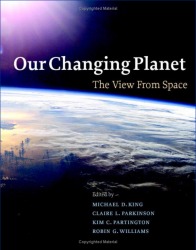A butterfly’s flapping wings may alter the weather a thousand kilometres away. This marvel of chaos also symbolizes Earth’s many interconnections. Such connections appear again and again in the book Our Changing Planet – The View From Space edited by M. King, C. Parkinson, K. Partington and R. Williams. Its collection of essays and vibrant depictions allow a reader to grasp meaning from random variability and arrive at a comprehension about the system that supports our lives on Earth.
The space age brought two great assets to weather forecasting; the satellite and computers. These tools allowed us to detect trends and relationships. For example, cold air over the Pacific Ocean during the spring time may lead to overly dry conditions along the west coast of the Americas. And, at a smaller scale, we see cities causing heat islands that effect their immediate climates. Through this experience, we can take current conditions and extrapolate them into the future. The goal is thus to ameliorate conditions, like tsunamis, that may be disadvantageous to human existence. However, this is a new field, so making predictions beyond a year, or perhaps a decade, still come with a great deal of uncertainty.
Nevertheless, we can make connections, and this book gives the reader an appreciation of what’s been done with our knowledge and where we might be going. The four editors; King, Parkinson, Partington and Williams have included within their book over 60 independent essays so as to provide a perspective of the dynamics of Earth. Most of these are weather related, though selections on plate tectonics, glaciers and vegetation show how weather affects and is affected by so much. For example, aerosols from ship’s exhaust cause a plume that satellites can detect well after the ship’s moved on. As well, Ebola outbreaks have a direct association with the end of rainy seasons. Also included within the book are little tidbits of information. An average hurricane will condense 20,000 million tons of water a day. And, over 1% of global total emission of man-made sulphur dioxide come from a few smelters at Noril’sk in north central Siberia. As these demonstrate, there’s little that can hide from today’s satellite technology, and this book readily shows this to great avail.
Yet, this book particularly shines through its illustrations. The book is physically of an overly large format. With this, the editors provide broad, expansive colour images, usually from satellites. For instance, a dramatic two page spread shows the mighty Lambert Glacier flowing out to the ocean. However, the book’s true bread and butter are the many GIS themed maps. Whether showing net primary productivity on a global scale or tsunami wave heights in the Indian Ocean, the reader is given simple yet informative visual pictures of the data. By providing a series of these maps, all annotated with dates, the reader can then easily grasp how our planet’s features change over time and how they effect all of Earth’s residents.
With the illustrations and their associated essays, the reader will see that the Earth changes. But, this isn’t news to anyone. And, this is a weakness of the book. The editors have omitted the inclusion of a common theme to drive the reader through the book. General interest and appreciation of great illustrations will start the reader into the book, but it may not be enough to keep them going. There’s an implicit understanding throughout the text that any change will affect humans. But, as people cover the globe, this comes as no surprise. Thus, the editors have missed an opportunity to build upon the knowledge. Especially, they’ve shied away from trying to combine trends seen from the individual case studies. It is apparent that the editors have gotten essays from very knowledgeable writers, but the writers appear to have worked mostly in isolation. Hence, aside from a general theme of a changing Earth, the essays have little that relate to each.
Nevertheless, this book makes for a great reference. In particular, it epitomizes the value of geographical information systems (GIS). With only rudimentary geographical knowledge, any reader can appreciate ebbs and flows across our globe. And, by the very nature of satellites, the reader will quickly forget about national boundaries and appreciate the inter-connected nature of our existence. However, this book keeps science within easy reach, more for the student or general reader than a researcher. Thus, though a wonderful reference either for data or for themes, this book is a starting point and a typical reader will be looking elsewhere to build upon the presentations.
With the Earth spinning by at well over 1600 kilometres an hour, many things get tossed and turned about. Add to this the effects of the occasional volcano and some very active residents, and, changes will abound. Such becomes readily apparent in the book Our Changing Planet – The View From Space edited by M. King, C. Parkinson, K. Partington and R. Williams. Through glowing illustrations and bright essays within it, our Earth becomes much more complete and more precious.


The Inter Galactic Universe System Groups
We share Highly intellect system to travel by mind concept use your ability to determined to transform without using the spaceship you can travel by mind energy system.
Ricky T. Bacolod
astronomer
The Greatest Research of INTER GALACTIC SYSTEM to apply the Law of Nature and Man to discover the BIOTECHNOLOGY to preserve the NATURE of Modernization of Green Changing World more scientist are focusing the Changing Planet insteed to Changing to distroyed the Mother earth some of Filipino Brilliant Ideas to discover the Techonology using application to save the BLUE PLANET of LIVING EARTH. We believe the International Federal State of the Philippines more apply the greatest research of Mother Earth as Forestation Modernization of back of the basic system.
look for I.F.S.P. Chairman Ricky T. Bacolod
Mobile: +639296601282